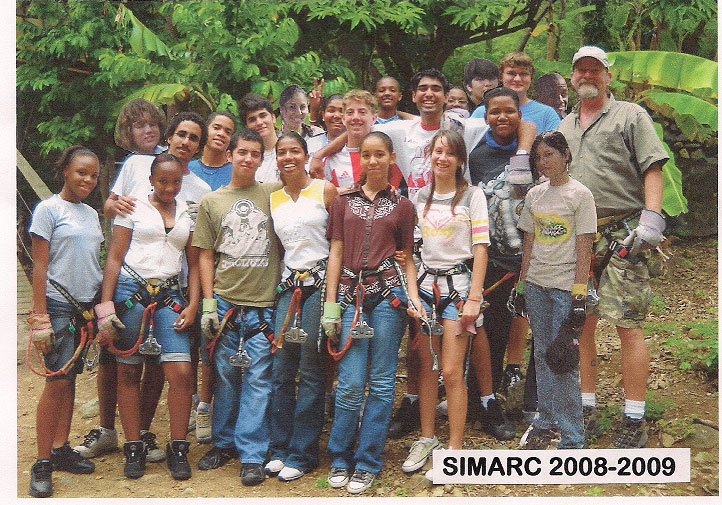 Founded on Martinique in 1961, the International Association for Caribbean Archaeology, IACA, is a group of archaeologists ranging from professionals to amateurs and students of archaeology in the region. These researchers from over 30 countries, meet every two years to hold a week-long conference to speak about what they have been investigating. These presentations are made simultaneously in three languages, English, Spanish, and French. This year, the IACA congress was at Antigua, and we travelled with our SIMARC director Dr. Jay Haviser who also presented papers on St. Maarten archaeology. This trip was generously sponsored by the Prince Bernhard Culture Funds and the Lion’s Club St. Maarten.
Founded on Martinique in 1961, the International Association for Caribbean Archaeology, IACA, is a group of archaeologists ranging from professionals to amateurs and students of archaeology in the region. These researchers from over 30 countries, meet every two years to hold a week-long conference to speak about what they have been investigating. These presentations are made simultaneously in three languages, English, Spanish, and French. This year, the IACA congress was at Antigua, and we travelled with our SIMARC director Dr. Jay Haviser who also presented papers on St. Maarten archaeology. This trip was generously sponsored by the Prince Bernhard Culture Funds and the Lion’s Club St. Maarten.
Our goal was to provide IACA members with information, hoping to impress and shed light on what we do as youth in our SIMARC archaeology program on St.Maarten. We used a powerpoint presentation created by the entire SIMARC class. The presentation was about SIMARC projects done from 2007-2009, following from an earlier presentation by other SIMARC students at the IACA Congress in Jamaica in 2007. Some of the projects we presented, included; the excavation of an 19th century priest; various site investigations, our Historic Tree Inventory and National Tree Day events, and our most recent project, revealing the original Simpson Bay bridges of both 1933 and 1950.
When we first heard about this congress, we were so excited because archeology fascinates us and could be a career direction for us, and we expected a lot of information as an overview of Caribbean archaeology. We ended up getting more information than we could ever imagine, even though some of the papers were very technical. We also got a chance to meet various university professors from around the world, which was a great opportunity for us because it raised our chances of studying abroad and networking. Although our paper was about 15 minutes, it certainly brought forth the SIMARC groups’ work. With many professionals congratulating us on a good presentation, we were also asked to give a copy of our report to be shown in a Youth Exhibit on Martinique. Various other organizations asked for a copy of our paper, and we arranged to cooperate with other youth programs in Antigua, Barbuda, and elsewhere.
When we presented our projects, many of the archeologists were astounded by our work and the translators were also very happy that we spoke slowly and clearly. Many said that our projects and presentation was better than some of the professionals. If there was one thing that we learned, it was that small projects like done by SIMARC and big projects like those by universities, combined together better reveal our full history, but you can't really say one is superior to the other.
One thing that surprised us was the realization that SIMARC is solely situated on St. Maarten, but we found out that other archeologists aren't tied to one place like us. One year they are on one island, the next year they are on another, so that also gave us a new point of view to archeology as a career. But this is because these other archaeologists mostly come from outside the region, while we are from here and so more attached to one island.
Another amazing thing was the fact that these professionals didn't treat us like kids, they treated us as their students, and some times even as equals. They heard us and what we had to say, they didn't brush us off as "just a buncha kids", they listened to us and also tried to learn from what we had researched. Many of the archeologists became our friends and we had many discussions around the dinner table and during our fieldtrips to historic sites and the Antigua museum, it was all just amazing.
The conference itself was a really good experience for us and provided us with good exposure to different forms of archaeology and methodology used in projects throughout the Caribbean. The different lectures gave us ideas on what else can be done on St. Maarten to preserve heritage and inform citizens of their islands’ history
This benefited not only us personally it also benefited SIMARC, because this showed that even though we are still "a buncha teenagers", we can do a good job for our community. But, we aren't just teenagers, we are St. Maarten teenagers, trying our best to save our islands’ heritage and also representing St. Maarten at such a prestigious conference. We were honored to make this presentation for St. Maarten, because not only did we represent our island, we also got to tell its’ tale!
We learned that the past is all around us, we live our lives against a rich backdrop formed by historic buildings, landscapes and other cultural survivals of our past. But the historic environment is more than just a matter of material remains, it is central to how we see ourselves and to our identity as individuals, communities and a nation of St. Maarten.
THROUGH SIMARC EYES.
This article is one more in a series compiled by the SIMARC students themselves to communicate to the St. Maarten community their experiences and observations relating to Archaeology and Culture of the island. SIMARC (St. Maarten Archaeological Center) is a youth program focused on teenagers, directed by Dr. Jay Haviser, with support from the Island Government as well as the private sector. The 2008-2009 SIMARC student authors of this article are: Christopher Velasquez (St. Maarten Academy) and Matthew Halley (St. Dominic High School).











